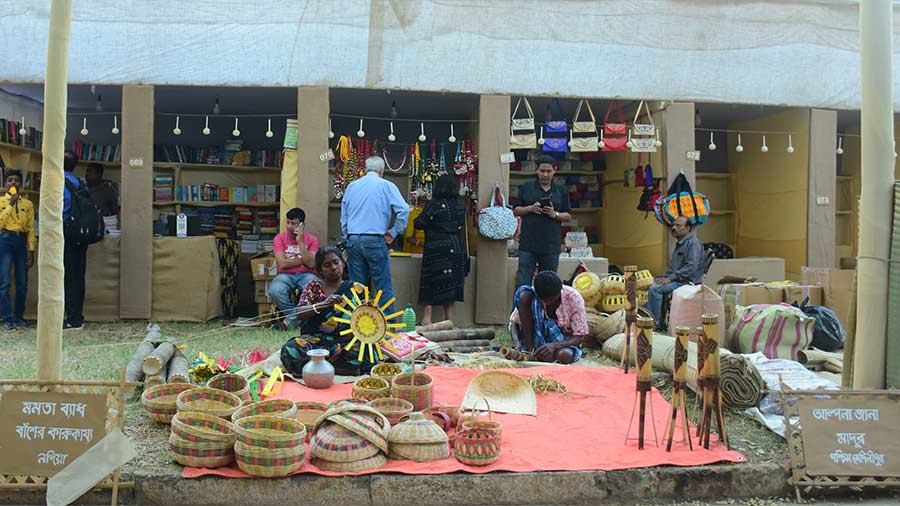The second day of the Nabanna Earth Weekend, in association with My Kolkata, started, fittingly, with a tribute to Tagore — the children of Mongrace Montessori House, Santiniketan, put up a dramatised performance of the Bard’s poem, Juta Abishkar, to an appreciative audience. Juta Abishkar tells the tale of King Habuchandra, who wanted a solution to the problem of his feet being dirty. The poem outlines, with Tagore’s unique take on humour, the various fixes that the king was offered before a leather artisan mustered up the courage to tell him that the solution lay in him covering his feet.
Aside from the delightful vigour and enthusiasm with which the children performed, it was the the underlying message of the performance — in keeping with both Tagore’s and Maria Montessori’s educational ideals — that hit home, especially in the context of Santiniketan: that societies, through its children and young people, should be moulded towards creative and independent thinking.
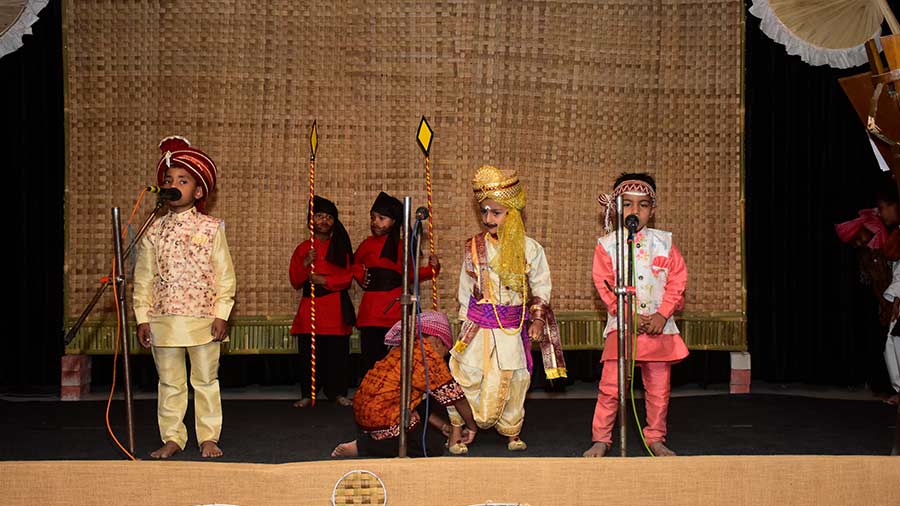
The students of Mongrace Montessori House, Santiniketan, perform Rabindranath Tagore’s ‘Juta Abishkar’
‘Sustainability cannot be accomplished by the push of a button’
The first session of the day, titled The Right Style, featured interior designer Minku Tagore, handloom expert Amitrasudan Saha and sustainable fashion designer Meghna Nayak in conversation with Ruchira Das, artistic director of Arthshila, all of whom dwelt largely on the question of making responsible lifestyle choices in the modern world, as climate change takes a turn for the worse and artisans’ rights and livelihoods die out.
“Our work involves engagement at the grassroots levels, in terms of being sustainable,” said Minku Tagore, whose four-room luxury bed and breakfast in Santiniketan, called Amoli, employs only local people.
“What does it even mean to run a sustainable company?” asked Nayak, who first learnt about the enormous and unjustified cost of the fashion industry while studying journalism, and went on to start her zero-waste fashion brand, LataSita. “Sustainability, as it exists now, is not accessible to everybody in terms of price points or how it works in this gentrified world, so that requires some degree of thought and engagement.”
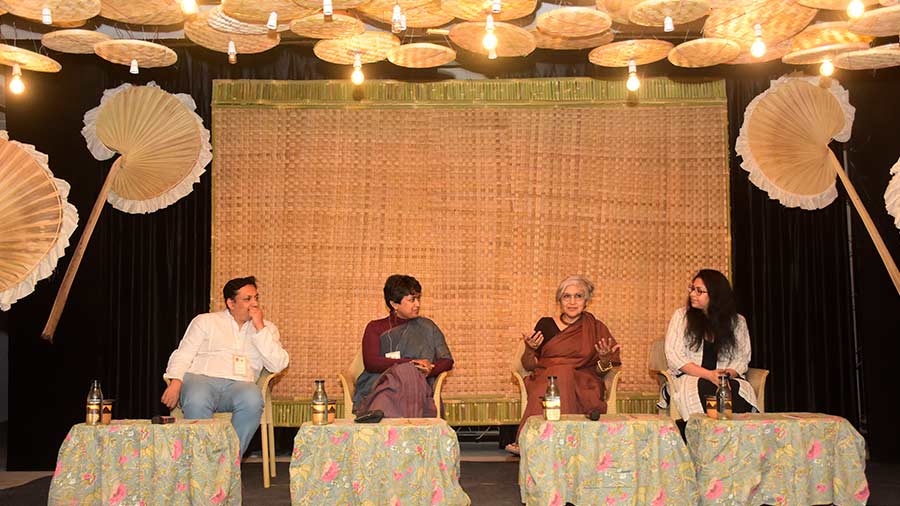
Amitrasudan Saha, Ruchira Das, Minku Tagore and Meghna Nayak during the session ‘The Right Style’
Saha believed that the first step towards achieving sustainable living involves teaching children about basic practices like not wasting food and re-wearing old clothes. “Sustainability cannot be accomplished by the push of a button,” he said, emphasising the value of storytelling traditions in the form of epics like the Mahabharat, which abound in stories with underlying messages of sustainability.
“Our artisans lack the confidence to price their products well; they need to be made to believe that they are the best.” Nayak also pointed out the glaring lack of protective regulations for artisans in India. “It is a plague,” she said. “Everything from chikankari to ikkat to kantha is being printed, and there are no laws in place to prevent anyone from doing this.”
“If we are buying something very cheap, then it’s either going to be of poor quality, or there will have been some exploitation somewhere down the line,” observed Das. “This awareness is of utmost importance.”
Shanta Ghosh, who was in the audience, also touched upon an important point: “There are two types of sustainability — the financial kind, that pertains to food, shelter and basic needs, and another kind that looks at how many traditional crafts are also polluting for the environment. These, and other questions, require a lot of thought and awareness-building among artisans.”
Where the two worlds meet
How do writers relate to, and respond to, the world (or worlds) they inhabit? How does the world always calling to us, in the form of events that demand reactions, make its way into one’s writing? These formed a few of the central questions in the day’s next session, Call and Response, featuring writer Sumana Roy, poet Iryna Vikyrchak and journalist-philosopher Krisha Kops in conversation with author-editor Anjum Katyal. “It’s often difficult to be aware of where the inner world ends and the outer world begins,” observed Roy, whose debut novel, Missing, ponders contemporary politics and modern-day culture through a clever retelling of an old story. “There is a very human urge to know what is happening not just inside ourselves, but also others. This demarcation of the inside and outside is something that 19th-century writers thought a lot about… the whole idea is constantly changing, and it’s this negotiation that we as writers, consciously or unconsciously, try to capture in our work.”

Anjum Katyal, Sumana Roy, Iryna Vikyrchak and Krisha Kops during the session ‘Call and Response’
“My response to the world and its events differs now from what it was a year ago,” said Vikyrchak, who is from Ukraine. “Since February 2022, when my country was attacked, the structure of my inner soul has been divided into multiple layers; this provoked some responsive mechanisms that changed my life as a writer and a poet.”
“From a philosophical point of view, we have to recapture or understand the world from a position that I call the ‘in-between’,” said Kops. “We have this tendency to perceive the world from and as ourselves, but there are ways of understanding the world from the in-between. As writers, we are the paragons of this in-between; we have to perceive and respond to the world in order to portray it in a way that fosters communication with other people.” The highlight of this session involved all the writers reading out excerpts from their works.
A complex relationship
The penultimate session of Day Two at Nabanna Earth Weekend, The Art and the Artisan, was a special one, with art historian R. Sivakumar and scholar Swati Ganguly talking about Santiniketan’s intricate and complex relationship with craft, including caste and gender divisions and the different goals of Sriniketan and Kala Bhavan in the artistic space.
A fascinating segment of the conversation pertained to alpana — which, along with batik and kantha, gets identified as having its roots in Santiniketan. “I believe that the alpana is typically not measured only by designs made on the floor; it is also a collective expression of art that is free-flowing,” observed Ganguly. “The designs emerge from the tips of human fingers. Typically, women would do the alpana; later, it became more rigid in its boundaries. It took on a life of its own, picked up by local artists who see it as a source of income.”
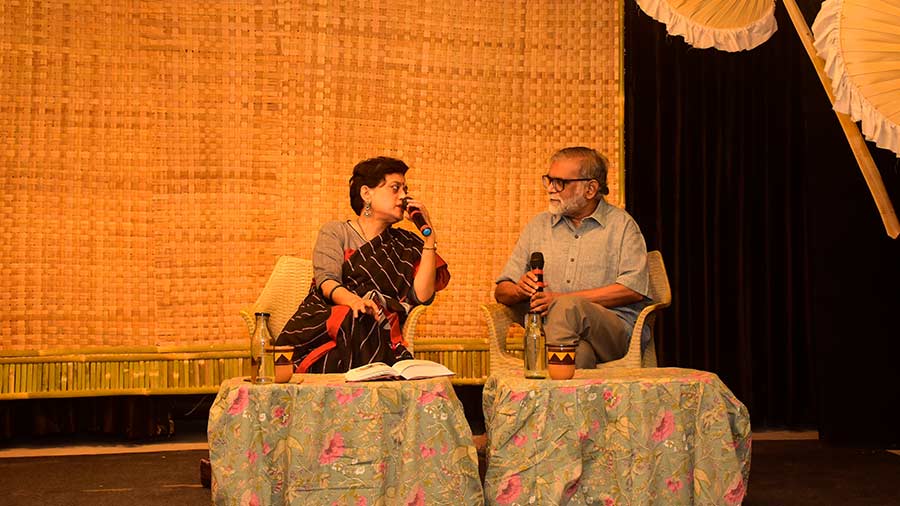
Swati Ganguly and R. Sivakumar discuss Santiniketan’s relationship with craft in the session ‘The Art and the Artisan’
“Alpana, in fact, was largely practised in Kala Bhavan, and not so much in Sriniketan; it was a question of what could or could not be marketed,” said Sivakumar. “It is interesting that the ephemeral was more promoted in Kala Bhavan. There are photographs of Ramkinkar Baij doing alpana. Many women students became sculptors, painters and potters, and several became designers. In Sriniketan, the social change was thus: initially, only traditional-caste practitioners would come; later, for crafts like pottery, leather and so on, non-traditional caste practitioners grew. The change in the class and caste structure in the production of handicrafts was a significant development.”
A hidden heritage
Among the most unique facets of Bengal’s history and architectural heritage are its terracotta temples. Talking to the audience about this fascinating part of the region’s landscape were professors Shreela Basu and Abhra Bose, whose joint research and knowledge on the subject are staggering. They were in conversation with Sukalyan Chanda in the special Bengali session, Banglar Terracotta Mandir. “We know about the famous terracotta mandirs, like those in Bishnupur, but there are several such temples all over Bengal that remain unseen, ignored or undiscovered,” said Chanda. “The terracotta work on the surfaces of these temples are an integral part of Bengal’s artistic and cultural heritage.”
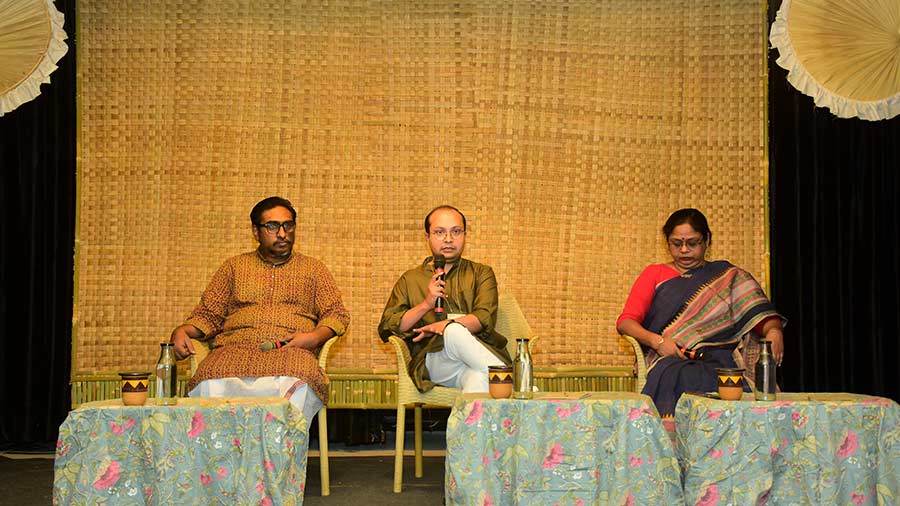
Abhra Bose, Sukalyan Chanda and Shreela Basu during the Bengali session ‘Banglar Terracotta Mandir’
What geographical, historical and cultural influences lay behind the construction of these temples? “Our religious, artistic and social histories are embedded in these temples,” said Shreela Basu. ‘More than 5,000 such temples were built across West Bengal and what is now Bangladesh. The author, Hitesh Ranjan Sanyal, was instrumental in shedding light on this. The southern parts of the region abounded in these structures, because of the availability of the clay required for terracotta. The creation of several of these terracotta temples were closely tied in with the Bhakti movement, central to which was Chaitanyadeb.”
Abhra Bose treated the audience to an audio-visual presentation of existing terracotta mandirs that illustrated the varied nature of the architectural styles of these temples — including the atchala-style Raghunath temple in Parul, and the jorbangla-style Krishnaroy temple in Bishnupur.

Bina Dey conducts a kantha workshop on the second day of the Nabanna Earth Weekend
A story of grit and skill
The power-packed second day of the Earth Weekend did not just have panel discussions; it also involved a workshop on kantha by the National Award-winning kantha artist, Bina Dey. At the age of 25, the shy, soft-spoken mother of two girls joined the Crafts Council of West Bengal with nothing but her skill with the needle and her desire to learn and earn a living. The testament to her grit and skill lay in the room full of women at the Gitanjali Cultural Complex grounds who were eager to learn from her.
Keep watching this space for reports on the final day of the Nabanna Earth Weekend!

